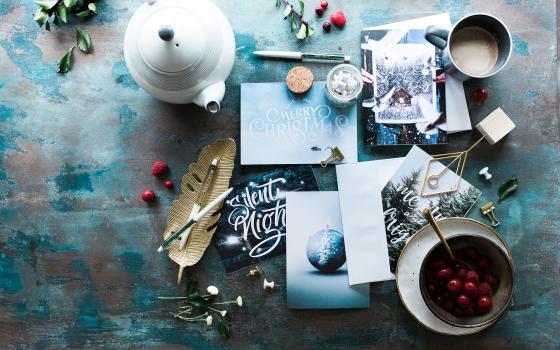As the Christmas holidays approach, in the northern hemisphere our side of the earth grows colder and darker. The nights grow quieter and the sun spends less time with us each day. Before our eyes, the year seems to drift into its own sleep as though making way for the New Year to be born.
As we move through this dark season, we are blessed with the gift of many important Advent and Christmas rituals that help to defeat the darkness and to keep warmth and light glowing in our souls.
We celebrate the outgoing year with family and friends. We share stories and food, trees and lights, gifts and church services. In the USA, the season of sharing begins at Thanksgiving, when we gather together to renew our gratitude for each other. December is busy with many activities. We send cards to tell family and friends our stories of the past year.
We bring an evergreen tree into our homes to remind us of life and growth when all else around us has gone dormant and is covered with snow. We decorate our trees with ornaments that carry memories of past Christmases. We string lights around our homes and trees to fill the night with light and to balance the darkness of our sleeping earth.
When days are at their coldest, we invite friends in and share our favorite foods. We turn to the warmth of companionship to ease the bitter cold. We give gifts to each other, images of something new to start the New Year. It is our faith communities that have created and nurtured many of these festivals and holidays. Celebrations such as Hanukah, Advent, Kwanzaa and Solstice bring comfort and hope to us all.
However, not all people share these joys during this time of year. Many within our communities, families and circles of friends find this season difficult — perhaps because of the loss of a loved one, difficult family relationships, economic hardship or illness.
Nevertheless, even to those facing dark times, these Christmas rituals often may provide some solace. Personally, when I am going through a difficult time, carols comfort me most, bringing back memories of past Christmases and our continued desire for peace. Those memories fill my eyes with tears.
I remember sitting with my mother during her last Christmas Eve night, after the rest of the family had gone home. The room was dark except for the tree lights and the reflection of their light on the patio windows. From the stereo came the sound of carols playing softly in the background. No words were needed between us, only silence and the comfort of warm memories of past Christmas Eves spent happily with family members no longer with us.
Advent rituals also provide joy at this cold and dark time of the year. Christmas preparations in the monastery were unique to me during my first months as a sister. We could not bring out decorations until December 24; we were committed to the four weeks of Advent as a time of waiting! It was a happy waiting, as when a new member is about to enter the community.
During Advent the songs of the Mass and in the Liturgy of the Hours of our daily office were our main way to express this ancient longing, hope and expectation. Singing fed our joy in each other’s abiding company as we waited together.
We did not decorate, or send out any personal Christmas cards until after December 25. But we did send at least two thousand cards during Advent to friends and supporters, whose donations were critical to our work. The cards carried our Christmas greetings as well as our gratitude for their financial support.
I was amazed at this major mailing production. These were the days before computers, and each card was addressed by hand. Some groups of sisters worked on the card design and message. Other groups printed the cards on the press in the monastery basement. We all gathered to prepare them for bulk mailing.
I can still see the tables in the dining room with paper signs for the different zip codes. We would take a handful of cards and find the right zip code pile for each one. After all the cards were in order, we counted them and put them in canvas bags. If all went well, we could do the sorting and counting in a day. After delivery to the post office, we waited anxiously hoping that they would not be returned because of some error. It took a community effort to accomplish this mailing feat, and we were pleased and proud of our work when all went well. It was a unique experience for me. I was used to buying gifts, whereas this communal work showed me another form of creating, giving and cooperation.
Another Advent custom that was different from my usual holiday experiences was the use of the “O” antiphons in the Mass and the liturgy of hours. The music was beautiful, but I was puzzled by the simple, ragged burlap hangings that appeared in our chapel on December 17, with an “O” antiphon on each one. My initial reaction was to look down on these tattered decorations. Couldn’t we do better?
I soon realized that the community considered these burlap decorations treasures from the past, much as I valued family Christmas tree ornaments brought out each year. Rituals like the card mailing and the yearly display of treasured decorations and ornaments were ways of expressing the desire and longing that we felt during this season. These customs fed our joy as we waited together.
During Advent, this darkest season of the year, we sing our carols and share our joy, our faith and our gratitude for each other. We embrace the religious rituals of the ages whatever our religious community might be. Our rituals carry us through darkness and into the light and the joy of new life, new hope and new joy that comes with the longer days and increasing light and warmth of the New Year, both in our hearts and in our daily lives.
[Laura Hammel is a member of the Sisters of St. Clare, a Poor Clare community in Saginaw, Michigan. In addition to the prayer ministry in her diocese, she has developed and maintained a website introducing different prayer forms useful at certain times of the year. These include an Advent calendar, contemplation using Stations of the Cross, a Pentecost Novena and Mysteries of the Rosary.]

